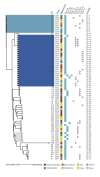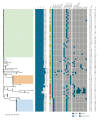Emergence of OXA-48-like producing Citrobacter species, Germany, 2011 to 2022
- PMID: 38606571
- PMCID: PMC11010590
- DOI: 10.2807/1560-7917.ES.2024.29.15.2300528
Emergence of OXA-48-like producing Citrobacter species, Germany, 2011 to 2022
Abstract
BackgroundCarbapenemase-producing Enterobacterales are a public health threat worldwide and OXA-48 is the most prevalent carbapenemase in Germany and western Europe. However, the molecular epidemiology of OXA-48 in species other than Escherichia coli and Klebsiella pneumoniae remains poorly understood.AimTo analyse the molecular epidemiology of OXA-48 and OXA-48-like carbapenemases in Citrobacter species (spp.) in Germany between 2011 and 2022.MethodsData of 26,822 Enterobacterales isolates sent to the National Reference Centre (NRC) for Gram-negative bacteria were evaluated. Ninety-one Citrobacter isolates from 40 German hospitals harbouring bla OXA-48/OXA-48‑like were analysed by whole genome sequencing and conjugation experiments.ResultsThe frequency of OXA-48 in Citrobacter freundii (CF) has increased steadily since 2011 and is now the most prevalent carbapenemase in this species in Germany. Among 91 in-depth analysed Citrobacter spp. isolates, CF (n = 73) and C. koseri (n = 8) were the most common species and OXA-48 was the most common variant (n = 77), followed by OXA-162 (n = 11) and OXA‑181 (n = 3). Forty percent of the isolates belonged to only two sequence types (ST19 and ST22), while most other STs were singletons. The plasmids harbouring bla OXA‑48 and bla OXA-162 belonged to the plasmid types IncL (n = 85) or IncF (n = 3), and plasmids harbouring bla OXA‑181 to IncX3 (n = 3). Three IncL plasmid clusters (57/85 IncL plasmids) were identified, which were highly transferable in contrast to sporadic plasmids.ConclusionIn CF in Germany, OXA-48 is the predominant carbapenemase. Dissemination is likely due to distinct highly transmissible plasmids harbouring bla OXA‑48 or bla OXA-48-like and the spread of the high-risk clonal lineages ST19 and ST22.
Keywords: Antimicrobial susceptibility, Carbapenemases, OXA-48, Citrobacter, Germany; Enterobacterales.
Conflict of interest statement
Figures






Similar articles
-
Early OXA-48-Producing Enterobacterales Isolates Recovered in a Spanish Hospital Reveal a Complex Introduction Dominated by Sequence Type 11 (ST11) and ST405 Klebsiella pneumoniae Clones.mSphere. 2020 Apr 8;5(2):e00080-20. doi: 10.1128/mSphere.00080-20. mSphere. 2020. PMID: 32269151 Free PMC article.
-
Carbapenem-Resistant Citrobacter spp. as an Emerging Concern in the Hospital-Setting: Results From a Genome-Based Regional Surveillance Study.Front Cell Infect Microbiol. 2021 Nov 11;11:744431. doi: 10.3389/fcimb.2021.744431. eCollection 2021. Front Cell Infect Microbiol. 2021. PMID: 34858870 Free PMC article.
-
OXA-181-Like Carbapenemases in Klebsiella pneumoniae ST14, ST15, ST23, ST48, and ST231 from Septicemic Neonates: Coexistence with NDM-5, Resistome, Transmissibility, and Genome Diversity.mSphere. 2021 Jan 13;6(1):e01156-20. doi: 10.1128/mSphere.01156-20. mSphere. 2021. PMID: 33441403 Free PMC article.
-
Rapidly spreading Enterobacterales with OXA-48-like carbapenemases.J Clin Microbiol. 2025 Feb 19;63(2):e0151524. doi: 10.1128/jcm.01515-24. Epub 2025 Jan 6. J Clin Microbiol. 2025. PMID: 39760498 Free PMC article. Review.
-
A brief insight into Citrobacter species - a growing threat to public health.Front Antibiot. 2023 Dec 5;2:1276982. doi: 10.3389/frabi.2023.1276982. eCollection 2023. Front Antibiot. 2023. PMID: 39816660 Free PMC article. Review.
Cited by
-
Optimal treatment of Imipenem and meropenem against bloodstream infections caused by the Citrobacter spp.BMC Infect Dis. 2025 Mar 17;25(1):366. doi: 10.1186/s12879-025-10760-6. BMC Infect Dis. 2025. PMID: 40091023 Free PMC article.
-
NDM- or VIM-producing Citrobacter spp. in Poland, 2011-19: high genetic diversity with broader representation of ST8, ST18 and ST22 global clones.Eur J Clin Microbiol Infect Dis. 2025 Jul;44(7):1723-1728. doi: 10.1007/s10096-025-05118-4. Epub 2025 Apr 9. Eur J Clin Microbiol Infect Dis. 2025. PMID: 40202601
-
Genomic characterization of a multidrug-resistant Citrobacter portucalensis isolate co-harboring bla KPC-2 and bla NDM-1 on distinct plasmids.Front Microbiol. 2025 Jul 16;16:1633493. doi: 10.3389/fmicb.2025.1633493. eCollection 2025. Front Microbiol. 2025. PMID: 40740322 Free PMC article.
-
Diversity and Resistance Profiles of ESBL-Producing Gram-Negative Bacteria from Dairy Farms in Southern Türkiye.Antibiotics (Basel). 2024 Nov 25;13(12):1134. doi: 10.3390/antibiotics13121134. Antibiotics (Basel). 2024. PMID: 39766524 Free PMC article.
-
In vivo evolution of ceftazidime-avibactam resistance in bla OXA-244-positive E. coli potentially linked to PBP3 insertion and mutations in acrB and PBP2.JAC Antimicrob Resist. 2025 Aug 1;7(4):dlaf137. doi: 10.1093/jacamr/dlaf137. eCollection 2025 Aug. JAC Antimicrob Resist. 2025. PMID: 40756421 Free PMC article.
References
MeSH terms
Substances
LinkOut - more resources
Full Text Sources
Miscellaneous
